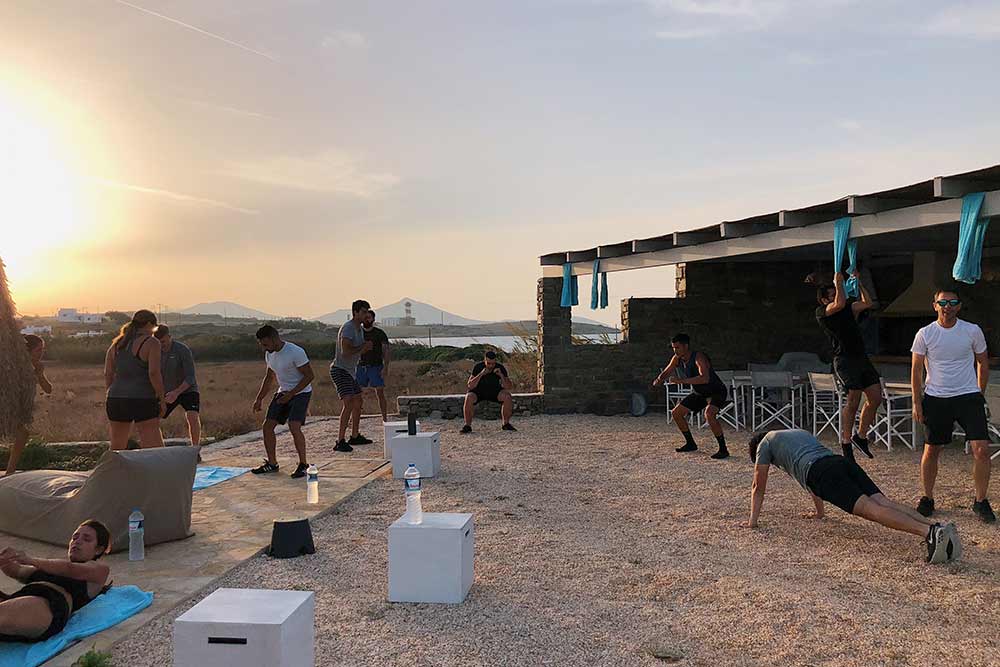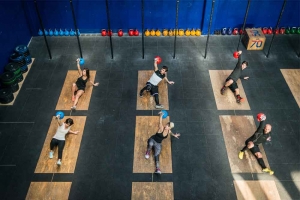What Does CrossFit Do to Your Body?

Hunter Bennett
As far as the world of exercise science goes, there tends to be a lot of research on most common training modalities – which is obviously a good thing.
You see, it is this research that allows identifying what style of training we should use to elicit a specific type of training adaptation. It essentially allows us to tailor our training perfectly to maximize health and performance outcomes.
However, over the last few years, we have seen a huge increase in popularity in one of the most intense forms of exercise on the planet – CrossFit.
But the research has been slow to catch up. Until now, that is.
What is CrossFit?
CrossFit is a unique type of fitness regime that sets itself apart from many others. It aims to improve nearly every aspect of physical fitness that you can think of, in a completely simultaneous manner.
It was created to optimize your ability manage ten distinct domains of fitness (Claudino, 2018). These domains include:

- Cardiovascular and respiratory endurance
- Stamina
- Muscular Strength
- Flexibility
- Muscular Power
- Speed
- Neuromuscular Coordination
- Agility
- Balance
- Accuracy
This is markedly different from most other training modalities, which typically aim to improve one or two domains at a time.
Related Article: The Rise of CrossFit
What does a CrossFit training session look like?
Considering the above, a single CrossFit workout is typically made up of several different exercises. These exercises are then performed for a high number of repetitions, and at an extremely high intensity – with practically zero rest between exercises.
It is important to note that, within this, there is a focus on frequently varying functional movements both within training sessions and between sessions.
As a result, CrossFit training frequently uses the following:
- Gymnastic style exercises (such as handstand and ring based exercises)
- Weightlifting exercises (such as barbell cleans and snatches)
- Traditional strength training exercises (such as barbell squats, deadlifts, and presses)
- Cardiovascular activities (such as running, skipping, and rowing) as exercises tasks.
And often within a single workout!
These specific training sessions are most commonly broken up into a ‘WOD’ (short for a ‘workout of the day’). This describes a combination of different exercises that collectively produce an incredible amount of metabolic, muscular, and cardiovascular fatigue.
What happens to your body during a CrossFit workout?
CrossFit has been increasing in popularity over the last decade. Only now are we seeing some research looking into how it affects the human body across the duration of a single workout (Maté-Muñoz, 2018).
I must admit, it is pretty darn interesting.
In a recent paper, some key exercise scientists aimed to investigate the effect that three distinct CrossFit workouts can have on various physiological measures within the body. The three workouts analyzed were:
- Cindy workout (a gymnastic style workout)
- Skip rope metabolic condition workout (an aerobic style workout)
- A power clean workout (a strength style workout)
Cindy
The Cindy workout consists of as many rounds as possible of 5 pull ups, 10 push ups, and 15 bodyweight squats, within a total time frame of 20 minutes. Each exercise had to be completed with optimal technique.
Skip Rope Workout
This unique metabolic conditioning workout is comprised entirely of double skip rope jumps performed in the form of a high-intensity interval training (HIIT) session.
In this manner, participants completed as many double skipping ropes jumps as possible across 8 sets of 20 seconds, with 10 seconds of rest between sets, for a total of 4 minutes in duration.
Short, but not sweet.
Power Clean Workout
Last but not least, we have the power clean WOD.
This specific weight lifting workout simply consisted of performing the maximum number of power cleans as possible in 5 minutes. The load they were using was equivalent to 40% of their pre-determined one repetition maximum, and the goal was to achieve as many reps as possible within the five-minute timeframe.
So, what happened?
Now, I am sure just by looking at these workouts you can see that they are somewhat brutal. Yes, while they are short compared to most traditional training routines, they are performed at an extremely high intensity.
Which is pretty much what we see with the results.
First and foremost, the maximum heart rate measures achieved for each of the three sessions got well above 90% of their predicted maximum – in short, they were close to working as hard as they possibly could.
Secondly, the amount of lactate they had in their blood shot straight through the roof.
For WOD one, they reached a whipping 12 mmol of blood lactate, for WOD two 10.3 mmol, and WOD three 11.5 mmol.
If these numbers don’t mean much to you, all you need to know is that your lactate threshold tends to occur at an exercise intensity corresponding with a measure of about 3 mmol of lactate in the blood (Stanula, 2013).
So, to put it bluntly, there were pretty much working above their lactate threshold the entire time.

Thirdly, they saw huge reductions in their maximal power outputs at the end of each workout, which indicates that not only were they under a lot of metabolic and cardiovascular demand, but they were also seriously stressing their muscular system as well.
Finally, the participants also rated their workouts in accordance to how challenging they perceived them to be. WOD 2 and 3 were rated as 15 (which corresponds with hard), while WOD 1 was rated a 17 (which corresponds with very hard).
As you can probably imagine, the workouts were tough!
Related Article: Predict Overuse Injuries In CrossFit Athletes
How is this different to other workouts?
Looking at these numbers, it becomes apparent that a typical CrossFit workout genuinely taxes every system in the human body.
From a cardiovascular perspective, your heart rate shoots through the roof.
Metabolically, your blood lactate rises exponentially.
The muscular system sees extreme fatigue, and your ability to produce force becomes severely inhibited.
Lastly, from an entirely mental perspective, the workouts are perceived to be very hard.
But you might be wondering how this differs from other workouts?
And the answer might surprise you…
You see, both the heart responses and the lactate accumulation observed in each of these three workouts are comparable to those observed during a HIIT session lasting around 38 minutes (Nicolò, 2014), or across an entire game of rugby (Granatelli, 2014).
The muscular fatigue observed is also thought to be quite similar.
Although it is important to state that with the CrossFit workouts, these measures were obtained in as little as 4 minutes.
Now while this really does give you some insight into how challenging these workouts can be – it should also provide an indication of how effective they can be.
What are the benefits of training CrossFit?
Considering the impact that these types of workouts can have on the human body, it should come as no surprise that they can have some serious benefits (Murawska-Cialowicz, 2015).
In fact, research has shown that sticking to CrossFit style training for as little 12 weeks can cause significant and simultaneous improvements in both muscle strength and aerobic fitness, while also causing reductions in body fat percentage and increases in muscle mass.
This provides a clear indication that this type of training very much does what it is intended to do.
You see, most other training modalities might cause an improvement in one or two of those measures, but not all of them at the same time.
Running (or any other form of cardiovascular exercise, for that matter) will cause improvements in aerobic fitness and assist to reduce your body fat percentage – but it certainly wouldn’t increase muscle mass or muscle strength.
Alternatively, weight training will increase muscle growth and muscle strength but will have minimal impact on aerobic fitness parameters.
Whereas CrossFit does it all.
What are the Health benefits of CrossFit?
It is important to note that with these impressive performance changes, you are also highly likely to see a myriad of associated health benefits.
Reductions in cardiovascular disease, diabetes, and obesity are a couple of key ones.
Moreover, these are highly likely to come with improvements in bone mineral density and increased strength. There is also an improved ability to perform tasks of daily living – it will literally make your life easier.
It seriously is one of the most bang-for-your-buck training methods on the planet.
Take Home Message
With the wonderful world of research finally catching up, we are only now starting to see how challenging CrossFit training is.
However, it is important to note that because of its demanding nature, it can also cause huge and simultaneous improvements in nearly every aspect of physical performance, while also enhancing health and wellbeing in the process.
In my mind, it truly lives up to the hype!
References
Claudino, João Gustavo, et al. “CrossFit Overview: Systematic Review and Meta-analysis.” Sports medicine-open 4.1 (2018): 11.
Maté-Muñoz, José L., et al. “Cardiometabolic and Muscular Fatigue Responses to Different CrossFit® Workouts.” Journal of Sports Science & Medicine 17.4 (2018): 668.
Stanula, Arkadiusz, et al. “Calculating lactate anaerobic thresholds in sports involving different endurance preparation.” Journal of Exercise Science & Fitness 11.1 (2013): 12-18.
Nicolò, Andrea, et al. “Neuromuscular and metabolic responses to high-intensity intermittent cycling protocols with different work-to-rest ratios.” International journal of sports physiology and performance 9.1 (2014): 151-160.
Granatelli, Giampietro, et al. “Match analysis and temporal patterns of fatigue in rugby sevens.” The Journal of Strength & Conditioning Research 28.3 (2014): 728-734.
Murawska-Cialowicz, E., J. Wojna, and J. Zuwala-Jagiello. “Crossfit training changes brain-derived neurotrophic factor and irisin levels at rest, after wingate and progressive tests, and improves aerobic capacity and body composition of young physically active men and women.” J Physiol Pharmacol 66.6 (2015): 811-821.
JOIN OUR NEWSLETTER
You Might Like:
















